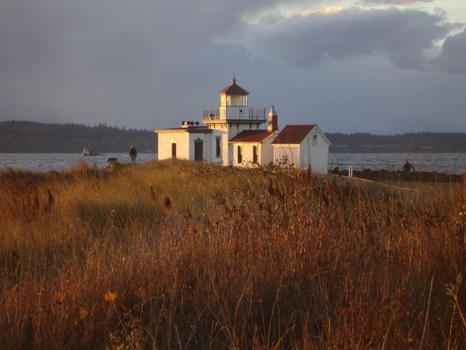Discovery Park - Seattle, WA

Discovery Park in Seattle is an exemplary model of land preservation in the heart of a highly urbanized environment. It is also a great example of an urban park that has done little or nothing in regards to the alteration of the natural landscape in which it inhabits. Discovery Park sits along the majestic, scenic shores of Elliott Bay, which feeds into the Puget Sound. It presents a classic scene of the rugged Pacific Northwest Shoreline geography. If one were to travel away from the greater Seattle metropolitan area, many of the waterfront vantage points would bear a striking resemblance to the park. The fact that city inhabitants can experience this without leaving the confines of Seattle is truly something for which to be grateful.
Discovery Park, at 534 acres, is the largest public park in Seattle and features over 11.8 miles of trails. It lies on the site of the former Fort Lawton, an old United States Army post. A large majority of this post, the entirety of the park, was given to the city of Seattle in 1973 and was immediately dedicated as a park. It was remarkable that Seattle chose this route, as the park sits on land that would be highly valuable for real estate development. The Magnolia neighborhood, which abuts the park, is one of the more higher-priced and desirable neighborhoods in the city. Seattle understood that it was much more important to preserve this land to promote the interests of citizens and increase the livability and attractiveness of the city as a whole.
The city of Seattle is certainly unique when compared to other similarly sized cities across the United States. An integral part of that has to do with the geographic isolation of the city. It is located in the extreme northwestern corner of the lower 48 part of the United States. Therefore, there are many features of Seattle's climate and natural landscape that make it stand out differ when compared to the rest of the country. Discovery Park largely represents what the Seattle area would feel like if human development had never occurred in this region. A moist maritime coastal climate characterized by abundant light rainfall dominates the area which contributes to the dense forests and meadows on sea cliffs throughout the region. The beaches along these shorelines are not gentle or calm, but instead are marked by rough, cold waters and currents and large amounts of driftwood. Therefore the beaches in the park are much more suited to exploration and quiet contemplation than sun-drenched relaxation.
Discovery Park also offers one of the best vantage points of the city. Looking westward, there are unobstructed views over Puget Sound towards the Olympic Mountain Range. It also possible to see the Cascade Range in the east as well. Discovery Park is a relatively new park when viewed from its official creation date. However, in its natural state, it looks like it has been around forever. And that is the true beauty of it, and land preservation in general.
Discovery Park, at 534 acres, is the largest public park in Seattle and features over 11.8 miles of trails. It lies on the site of the former Fort Lawton, an old United States Army post. A large majority of this post, the entirety of the park, was given to the city of Seattle in 1973 and was immediately dedicated as a park. It was remarkable that Seattle chose this route, as the park sits on land that would be highly valuable for real estate development. The Magnolia neighborhood, which abuts the park, is one of the more higher-priced and desirable neighborhoods in the city. Seattle understood that it was much more important to preserve this land to promote the interests of citizens and increase the livability and attractiveness of the city as a whole.
The city of Seattle is certainly unique when compared to other similarly sized cities across the United States. An integral part of that has to do with the geographic isolation of the city. It is located in the extreme northwestern corner of the lower 48 part of the United States. Therefore, there are many features of Seattle's climate and natural landscape that make it stand out differ when compared to the rest of the country. Discovery Park largely represents what the Seattle area would feel like if human development had never occurred in this region. A moist maritime coastal climate characterized by abundant light rainfall dominates the area which contributes to the dense forests and meadows on sea cliffs throughout the region. The beaches along these shorelines are not gentle or calm, but instead are marked by rough, cold waters and currents and large amounts of driftwood. Therefore the beaches in the park are much more suited to exploration and quiet contemplation than sun-drenched relaxation.
Discovery Park also offers one of the best vantage points of the city. Looking westward, there are unobstructed views over Puget Sound towards the Olympic Mountain Range. It also possible to see the Cascade Range in the east as well. Discovery Park is a relatively new park when viewed from its official creation date. However, in its natural state, it looks like it has been around forever. And that is the true beauty of it, and land preservation in general.
Temple of the Dog, a one-time Seattle group featuring members of local legends Soundgarden and Pearl Jam, certainly realized the potential and haunting imagery of the park and utilized it in filming the entire video of the early 90s hit song "Hunger Strike". A fitting conclusion:

